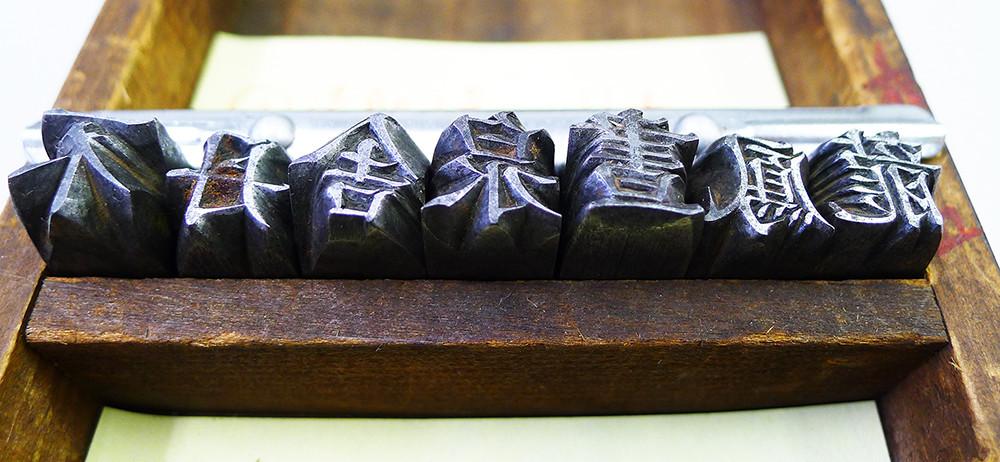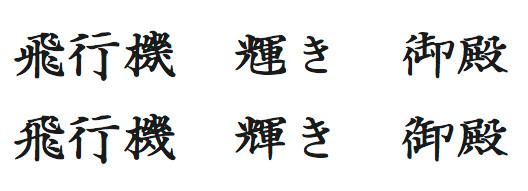
Antic, Song Dynasty, Kodoken Qing Dynasty-Historical characters
Antic body manga blowout typeface
In the beginning of the 2000s, Mr. Hashimoto worked on the original character of some brush typefaces in Iwata.
First of all, what I worked on in May 2003 was Anticky.Antic body is a thick wooden typeface that matches Gothic kanji, and has been used for manga wiping and dictionary headlines.Although it is a pseudonym for the ming -morning body, it is said that the difference between the thickness of the vertical and horizontal and horizontal is smaller than that of the Mincho body.Iwata's anti -body is not only a kana typeface, but is developed as a single typeface, including the kanji of the thick gothic body (only B is announced).Originally, it was produced after receiving an order from a client who wanted to use it for manga.
"I have drawn a new drawing about the kana. The concept is" Publish name for ordinary brush writing. "It gave a slightly soft atmosphere of the wind. "
Song Dynasty-Reprinting Metal Type
The next thing I worked on was the Song Dynasty.It is a reprint of the metal type "Hido Song Body" originally owned by Iwata Mother Manufacturing (the production period is May 2002 to April 2004).The Song Dynasty is a traditional typeface featuring sharp painting lines and sharp points.Although there are vertical long and sectaries and the Song, the Iwata Song Dynasty is a digitized typeface based on Iwata's mother -in -style.
First, scanning "clear printing" of 10 Song dynasty characters, which is printed neatly and burned into a print paper, and the Yamagata Division converted it into data with IKARUS (font production system).Based on those 10 characters, Mr. Hashimoto drew the original character.Based on that, the characters of the letters are compiled in the image table, and the parts of the Yamagata Division create a basic 500 characters using the parts.Here, when the images and line width of the typeface were collected, the characters were increased at a stretch.During the type of type, only 4000 to 5000 characters per typeface had to be newly created for digital fonts.
In creating kanji, it was said that the lower right of the horizontal line and the variation of the text stable were eliminated.
"The metal type Song Dynasty body was a character that was created to make one character cool, so the variation was large for each character. The upper right is basically, but for example, in the" mountain "and" country ", it rises.It was often different. Originally, it was a typeface that was often used in business cards. Unlike books, the text of business cards does not form a long sentence, and the last name and name are separated.So, if one character was cool, it would have been nice to have some variation.
However, in the case of digital fonts, the correction was made so that the variation of kanji could be reduced and the text could be assembled.
The reprinted version of the Song Dynasty has a very unique design.
"Some people said that it was good, but some people said that it was too unique and difficult to use. I think that extremely unique kana alone will narrow the use, and create a simple kana arranged a little more modern.I did it. That's "New Gana." It's strange that kanji looks like a modern style when combined with Shinja. "

Shin Gana was produced in June 2006.Currently, two typefaces, "Iwata Song Dynasty" and "Iwata Song Dynasty," are lined up.
Kodoken Qing Dynasty-Character born in Meiji 9
In March 2003, a reprint of the Seicho Dynasty was produced.This is also a reprint of metal type, but it dates back to the Meiji era.
The Kodoken Qing Dynasty is a print of a square style, launched in 1876 by a livelihood factory called "Kodenken" founded by Masayoshi Kanzaki in 1874 (Meiji 7).It is a typical typeface from the mid -190s to the 20s, including being used in the textbooks for the Tokyo Nichi -Nichi Shimbun for about 10 years since 1881.The mother type used a punch mother type (driving type mother type), which was rarely used in Japan at the time, and the species (father type) were directly carved into steel steel steel.(*1)
It is the No. 4 Qing Dynasty that was reprinted as a digital font by Iwata.Two typefaces, a "reprint version" that faithfully reproduces the print, and the "modern version", which is almost compliant with the JIS font, leaving an old -fashioned image, and has a 10%larger pseudonym.
"The Koden Qing Dynasty also created the original characters based on the clear prints burned on the film.I made it from materials such as motheroids and prints. It is a beautiful type, but from a modern sense, the pseudonym was quite small. It would be better to have a bigger name to form a sentence., 10%larger "modern version" was created. In the modern version, the shape is modern, so there is no base character, so I did a lot of writing. The original metal type is 2000 to 3000 characters.I guess it was only about it. "
Difficulty of reprint
Like the Song Dynasty and the Kodoken Qing Dynasty, it may not be so difficult to reprint in the original metal type because it has a base character.When you think about it, you think so, but what about it?
"It is said that there is the word" Moto "when making a reprinted typeface, but what is there as" Motomoto "is a big problem first. In the case of the Iwata Morning Old, Benton sculpture.In order to create a pattern for aircraft, there was a "original character" made on paper. This is based on this. However, the Song Dynasty and Kodoken Qing Dynasty are printed on printed prints with metal prints.The "clear printing" burned into the "original". As a printed material, it is a beautiful print, but it is printed by attaching the ink to the convex type and pressing it to the paper.It is a print printing. Due to its structure, the printed one has a thick outline = marginal zone, so it is inevitable that the letters will gain weight. "
"The way of the marginal zone depends on the time, and some bleeding will come out. When scanning and tracing this clear printing, it is difficult to find out as an outline of the font. It is not outside the marginal zone.Gosho, it is not clear where the end of the type is in clear printing. However, it is not possible to trace the metal type itself as it is.If you do not draw the outline while considering, it will become a blurred typeface. "
Modification based on the characteristics of the print printing is required in digital font work.Depending on the repair, it may become another typeface.
"In the end, the key is" whether it has a reputation for the typeface "is the key. Is it the power to properly evaluate the quality of the completed thing? If this is not the case, even if it was originally a typeface., It will be halfway quality. "
In the past, when designing a metal type typeface, the letters were made sharply, anticipating the letters in print.The typeface was designed in anticipation of the expression technology of printing printing and the deformation of it -the state when the reader finally touched the reader's eyes.The same consideration is required for digital fonts.
As the fonts are touched by the reader's eyes through printing and screen display, it is necessary to (sometimes imagine) the characteristics of a certain kind of "deformation" caused by expression technology.In addition, based on that, what is the now required shape? For example, when the "Iwata Ming Dynasty Old" is produced, the original character is used as a digital font as it is.Because the horizontal line is so thin that the horizontal line flies, it is important to maintain the atmosphere of the typeface, such as maintaining the thickness of the horizontal line.
(to be continued)
*1: About the Women's College of Art, Kodoken Qing Dynasty Dogs Related Dogital Archive "Kodoken Qing Dynasty Body Price"
Speaker profile
Kazuo Hashimoto, Kazuo, a typeface designer.Iwata advisor.Born in Osaka in February 1935.In June 1954, he joined the printing and sales company, Motoya.He is involved in the production of the Benton sculpture under the Taisa Genzo.In May 1959, he joined Shaken, a major manufacturer of photo -planting machines.He produced the original character of the Ishii Song Dynasty under the supervision of the founder, Shigeyoshi Ishii.After Mr. Ishii died in 1963, he supervised almost all typefaces produced and released in Shaken until the 1990s, as the chief of the company's character club.Retired from Shaken in August 1995.After a freelance period, he began to supervise and design digital fonts from around 1998, and became an advisor to the company.He is up to the present.
Author profile
Akari Yuki (Yuki / Akari) writer, editor.Born in 1971.She was in a printing company during the transition from copy to DTP, and she became freelancer since 2000 after working as an editor -in -chief of a business magazine.She writes and writes in fields such as letters, designs, printing, and handicrafts.He has authored "Design of drawing characters", "Background of designs to listen to Mojibe Focuser Designers, Tips for Selecting Fonts and Fonts" (Graphic), "Nine Focused Designers Making Characters" (Seibundo Shinkosha), and "Target Gold Sculptor Kinnosuke Shimizu (Kinnosuke Shimizu's Books), editorial books in the book in charge of the story and planting of the typeface I made, and the design of Kozuka typeface (Masahiko Kozuka, Graphic) and many others.。She is a regular editor, "She is a design" magazine.
■ This series is posted every other week.The next time will be published at 10:00 AM on June 16th.
